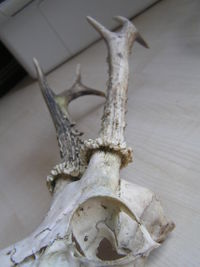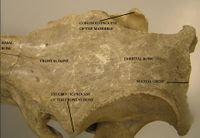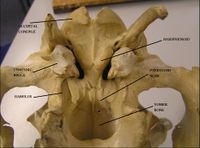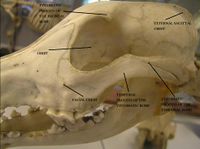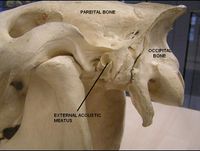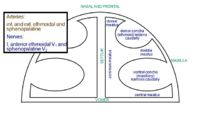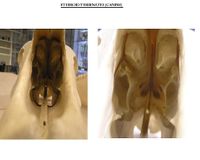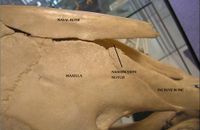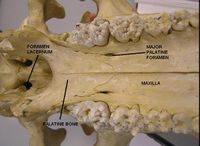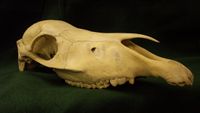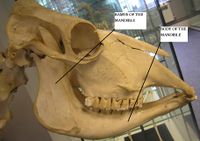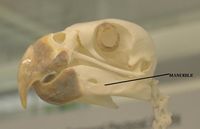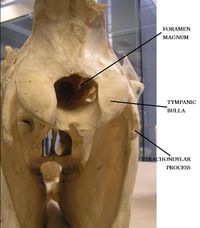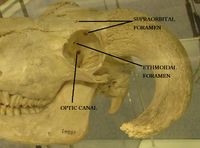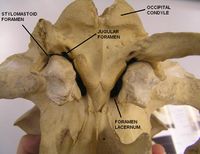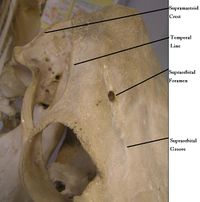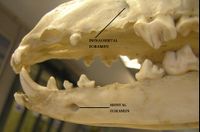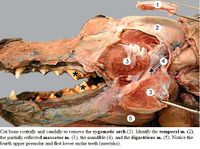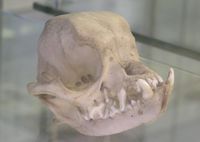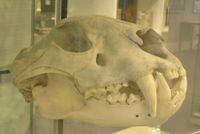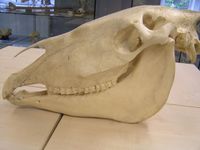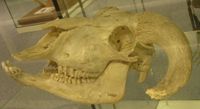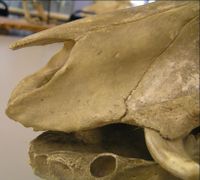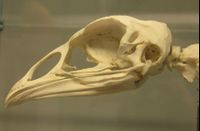Difference between revisions of "Skull and Facial Muscles - Anatomy & Physiology"
Fiorecastro (talk | contribs) |
Ggaitskell (talk | contribs) |
||
| (5 intermediate revisions by 3 users not shown) | |||
| Line 1: | Line 1: | ||
| − | + | {{OpenPagesTop}} | |
== Introduction == | == Introduction == | ||
| Line 61: | Line 61: | ||
=== Vomer === | === Vomer === | ||
| − | The vomer is unpaired and extends from the choanae of the palatine bone to the floor of the nasal cavity. It attaches to the median | + | The vomer is unpaired and extends from the choanae of the palatine bone to the floor of the nasal cavity. It attaches to the median nuchal crest and has a '''septal sulcus''' which surrounds nasal cavity. <br> <br> |
=== Pterygoid Bone (''os pterygoideum'') === | === Pterygoid Bone (''os pterygoideum'') === | ||
| Line 81: | Line 81: | ||
== Facial Muscles == | == Facial Muscles == | ||
| − | The major facial muscles are covered in the following sections of anatomy and physiology: | + | [[Image:Muscles of Mastication.jpg|thumb|right|200px|'''Muscles of Mastication''', C.Clarkson and T.F.Fletcher, date unknown]] The major facial muscles are covered in the following sections of anatomy and physiology: |
[[Tongue - Anatomy & Physiology#Muscles|Muscles of the Tongue]] | [[Tongue - Anatomy & Physiology#Muscles|Muscles of the Tongue]] | ||
| Line 125: | Line 125: | ||
[[Image:Bird skull.jpg|thumb|right|200px|'''Bird skull''', nabrown, 2008]] Birds have '''pneumatised skull bones''' which connect to airways in the head rather than the air sacs. They have large orbits and their skull plates are separated by spongy bone. A '''single occipital condyle''' articulates with the '''atlas''' allowing more rotation of the head. In parrots, the nasal bone and frontal bone are joined by a flexible cartilage structure allowing greater jaw opening which is called the craniofacial hinge. This allows kinesis to occur. Birds have thin '''jugal arches''' (equivalent to zygomatic arch) and the middle ear contains only the columella (equivalent to the stapes). <br> <br> | [[Image:Bird skull.jpg|thumb|right|200px|'''Bird skull''', nabrown, 2008]] Birds have '''pneumatised skull bones''' which connect to airways in the head rather than the air sacs. They have large orbits and their skull plates are separated by spongy bone. A '''single occipital condyle''' articulates with the '''atlas''' allowing more rotation of the head. In parrots, the nasal bone and frontal bone are joined by a flexible cartilage structure allowing greater jaw opening which is called the craniofacial hinge. This allows kinesis to occur. Birds have thin '''jugal arches''' (equivalent to zygomatic arch) and the middle ear contains only the columella (equivalent to the stapes). <br> <br> | ||
<br> | <br> | ||
| − | |||
| − | |||
{{Learning | {{Learning | ||
|flashcards= [[Skull - Musculoskeletal - Flashcards|Skull]]<br>[[Facial Muscles - Musculoskeletal - Flashcards|Facial Muscles]] | |flashcards= [[Skull - Musculoskeletal - Flashcards|Skull]]<br>[[Facial Muscles - Musculoskeletal - Flashcards|Facial Muscles]] | ||
| Line 135: | Line 133: | ||
| − | + | {{OpenPages}} | |
| − | + | [[Category:Musculoskeletal_System_-_Anatomy_&_Physiology]] [[Category:A&P Done]] | |
| − | |||
| − | [[Category:Musculoskeletal_System_-_Anatomy_&_Physiology]] | ||
[[Category:Needs splitting]] | [[Category:Needs splitting]] | ||
| + | [[Category:Dental Anatomy - Small Animal]] | ||
| + | [[Category:LisaM reviewing]] | ||
Revision as of 16:00, 2 July 2014
Introduction
The shape and size of the skull varies widely, not only between species but also with age, breed and sex of similar species. The skull is divided into three components - the neurocranium, the dermatocranium and the viscerocranium. The skull also includes the hyoid apparatus, mandible, ossicles of the middle ear and the cartilage of the larynx, nose and ear. The skull protects the brain and head against injury and supports the structures of the face. In some animals the skull is also used for defensive actions, for example in horned ungulates such as red deer stags. The neurocranium develops from the neural crest and mesoderm and undergoes endochondral ossification. It lies ventral to the brain. The dermatocranium lies dorsal to the brain and develops from the neural crest and mesoderm. It undergoes intramembranous ossification. The viscerocranium is the pharyngeal skeleton. It is derived only from the neural crest and undergoes endochondral and intramembranous ossification. The various facial muscles attach onto the skull in different places depending on their function. Movement of the external appendages, mastication and facial expressions all rely on the movement of the facial muscles.
Structure
The skull is made of many small bones, most of which are paired. Cartilage or fibrous tissue separates the bones of the skull in the young animal and once growth has ceased, the sutures begin to ossify.
Function
The skull has various functions including protection of brain, support of the facial muscles by providing origin and insertion sites, development of foramen to provide entry and exit places for the vasculature and nervous system and a defense function.
Bones of the Skull
Occipital Bone (os occipitale)
The occipital bone forms the nuchal wall and the foramen magnum. The pars basilaris element is the caudal base of the cranium, although rostral to foramen magnum and joined by a cartilagenous suture to basisphenoid bone. It has muscular tubercules on ventral surface where the flexors of the head and neck attach and a caudocranial fossa encloses the pons and medulla oblongata. The squamous part (pars squamosa) is dorsal to lateral parts and occipital condyles. A nuchal crest is present and is easily palpable. The nuchal crest is often used as a landmark for collection of cerebrospinal fluid (CSF). There are also external occipital protuberances present which provide muscle attachment sites for the nuchal ligament. The lateral parts (partes laterales) form the borders of foramen magnum. Occipital condyles are present which articulate with the atlas to form the atlanto-occipital joint. The paracondylar process provide muscle attachment sites for muscles of the head. The hypoglossal canal is also within this structure.
Sphenoid Bone (os sphenoidale)
The sphenoid bone forms the base of the neurocranium and is composed of a body and wings. The bones are separated by cartilage which ossifies with age. The presphenoid (os praespenoidale) is rostral and has a caudal fossa which is a hollow body with sphenoid sinuses located inside. Within the sinuses are the optic chiasma and optic canal. The basisphenoid (os basispenoidalis) is caudal and has a median cranial fossa. The wings oppose the temporal bone, maxilla, orbit and the brain. The wings also form the oval foramen and other foramena (see species differences) including the carotid notch, oval foramen and spinous notch (in the horse). The pterygoid processes are also present.
Temporal Bone (os temporale)
The temporal bone is composed of squamous, petrosal and tympanic parts and forms the lateral wall of the cranial cavity. It articulates with the frontal, parietal and sphenoid bones. The squamous element joins the temporal process of the zygomatic bone to form the zygomatic arch and forms the articulating surface of the temporomandibular joint. An articular tubercle and mandibular fossa are present. Occipital process and retrotympanic processes surround the external acoustic meatus whilst the petrosal part encloses the inner ear internally via the internal acoustic meatus. Ventrally this structure forms the mastoid process. The styloid process attaches the hyoid apparatus and a stylomastoid foramen is also present. The tympanic part is the ventral section of the temporal bone containing the tympanic bulla. The tympanic membrane separates tympanic cavity from external acoustic meatus and encloses the auditory ossicle dorsally. The musculotubal canal contains tensors of the soft palate.
Frontal Bone (os frontale)
The frontal bone is a paired structure joined by the interfrontal suture between the cranium and the face and enclosing the frontal sinuses. The nasal and lacrimal bones border the frontal squama section and form the zygomatic process laterally and part of the orbit dorsally. Lacrimal glands are also present near the orbit. The temporal line extends into the external sagittal crest. Ruminants also have a cornual process in horned variants. The nasal section is the rostral part of the frontal bone and the orbital part is perforated by the ethmoidal foramen. Medially the dorsal oblique muscle of the eyeball attaches. The temporal part provides the muscle attachments for the temporalis muscle.
Parietal Bone (os parietale)
The parietal bone is a paired structure and forms the dorsolateral wall of the cranium with the cccipital bone caudally and the frontal bone rostrally. It is composed of a parietal plane, temporal plane and a nuchal plane (in the ox). Internally the grooves and ridges correspond with the gyri and sulci of the brain. There is also an interparietal bone between the occipital bone and the parietal bone which fuses with age.
Ethmoid Bone (os ethmoidale)
The ethmoid bone forms part of the cranial and facial parts of the skull and is located deep in the orbit. External lamina consist of the roof plate, floor plate and paired orbital plates. The ethmoid bone is separated from the cranial cavity by the cribiform plate. Numerous small foramina exist where the olfactory nerve (CN I) passes through. The perpendicular plate splits the ethmoid into two halves and the ethmoid larbyrinth protrudes from the ethmoid tubes. The tubes are composed of two rows of ethmoturbinates and air filled ethmoidal meatuses. Secondary ethmoturbinates may also be present. Ethmoturbinates are divided into endoturbinates and ectoturbinates. The first endoturbinate forms the dorsal nasal conchae and the second endoturbinate froms the middle nasal conchae. The endoturbinates form 3 nasal meatuses; the dorsal nasal meatus, the middle nasal meatus and the ventral nasal meatus.
Nasal Bone (os nasale)
The nasal bone is a paired structure and forms the roof of the nasal cavity. Dorsal nasal conchae attach to the ethmoidal crest on the internal surface. A rostral suture forms the apex and between the nasal and incisive bones is the nasoincisive notch.
Lacrimal Bone (os lacrimale)
The lacrimal bone forms part of the lateral wall of the face and orbit and is situated near the medial canthus. It articulates with the frontal bone, zygomatic bone and maxilla. It also articulates with the nasal bone in ruminants and the horse and articulates with the palatine bone in carnivores. It is composed of an orbital and facial part separated by supra- and infraorbital margins. The nasolacrimal duct is present by the margin of the orbital surface. The ventral oblique muscle attaches caudal to the margin of the orbital surface. The nasal surface forms the boundaries of the maxillary and frontal sinuses.
Zygomatic Bone (os zygomaticum)
The zygomatic bone is lateral and ventral to the lacrimal bone and forms the orbit and zygomatic arch. The supraorbital margin is formed by the zygomatic process of the temporal bone and the frontal process of the zygomatic bone. The facial crest is present on lateral surface.
Incisive Bone (os incisivium)
The incisive bone is a paired structure composed of body, nasal, palatine and alveolar parts. It joins with the maxilla to form the interalveolar margin. It also forms the rostral part of the facial section of the skull, the roof of the hard palate and the opening to the nasal cavity. The alveolar process forms conical sockets for the incisor teeth.
Palatine Bone (os palatinum)
The palatine bone is a paired structure between the maxilla, sphenoid and pterygoid bones. It is composed of a horizontal plate (forms part of the hard palate), perpendicular plate (forms the dorsal and lateral walls of the nasopharyngeal meatus) and the choanae. The nasal crest present on the horizontal plate. The palatine sinus is present on horizontal plate.
Vomer
The vomer is unpaired and extends from the choanae of the palatine bone to the floor of the nasal cavity. It attaches to the median nuchal crest and has a septal sulcus which surrounds nasal cavity.
Pterygoid Bone (os pterygoideum)
The pterygoid bone is a paired structure bordered by the palatine and sphenoid bones. It forms the dorsal and lateral walls of the nasopharyngeal cavity. The pterygoid hamulus is formed by the pterygoid bone.
Maxilla
The maxilla forms most of the facial part of the skull, including the lateral walls of the face, nasal cavity, oral cavity and hard palate. It also forms the ventral nasal conchae and articulates with all of the facial bones as it is the largest bone of the face. The maxillary body encloses the maxillary sinuses and forms the external surface of the face. It also forms the facial crest. The infraorbital foramen is palpable. The conchal crest is on nasal surface where the ventral nasal conchae attaches. The lacrimal canal opens into the lacrimal foramen on the nasal surface. The pterygopalatine surfaces are the caudal part of the maxilla which terminate in the maxillary tubercle where the sphenopalatine, maxillary and caudal palatine foramen are present. The alveolar processes present are separated by interalveolar septa. The palatine process forms the hard palate with the palatine bone. The palatine fissure is formed at the articulation with the incisive bone. The nasal surface of palatine process forms the nasal crest and encloses part of the palatine sinuses. The oral surface has numerous palatine foramina present.
Mandible (mandibula)
The mandible can be divided into the body and the ramus. The body of the mandible supports the incisor teeth (rostrally) and cheek teeth (caudally). The section of the body which does not support any teeth is called the interalveolar margin or diastema. The mandibule also contains the mandibular canal and the mental foramen. The facial notch is on the ventral surface where the parotid duct (in herbivores) and facial vessels run. The ramus extends from the caudal end of the body dorsally towards the zygomatic arch. The masseter muscle attaches to the lateral surface at the masseteric fossa. The medial pterygoid attaches to the medial surface at the pterygoid fossa. The angle of the mandible terminates dorsally in the condylar process and the coronoid process which are separated by the mandibular notch. The temporal muscle inserts onto the coronoid head. The condylar process articulates with the mandibular process of the skull (see here).
Major Foramen and Canals
The jugular foramen is located either side of basilar part of occipital bone, adjacent to tympanic bulla and contains the glossopharyngeal nerve (CN IX), vagus nerve (CN X) and accessory nerve (CN XI). The jugular foramen also contains the internal carotid artery. The foramen magnum is formed by the occipital bones and is the spinal cord's passage to the neck and body. The alar ligaments run through the foramen magnum together with vertebral arteries, spinal arteries and tectoral membranes. The hypoglossal canal is between paracondylar and condylar processes on lateral part of occipital bone. The hypoglossal nerve (CN XII), condylar artery and condylar vein all pass through. The optic chiasma runs in a transverse depression behind the sphenoid rostrum on presphenoid bone and facilitates the path of the optic nerve (CN II).
The optic canal passes from the optic chiasma over wings of the presphenoid bones and facilitates the path of the optic nerve (CN II). The oval foramen is found within the caudal wing of the basisphenoid bones and the mandibular branch of the trigeminal nerve (CN V3) passes through it. The alar canal is formed by the rostral border of the basisphenoid bone at the base of the pterygoid processes. It is composed of the caudal alar foramen, rostral alar foramen and the small alar foramen. The maxillary branch of the trigeminal nerve (CN V2) passes through together with the temporal artery.
The stylomastoid foramen is situated on the petrosal part of the temporal bone and allows the facial nerve (CN VII) to pass through. The ethmoidal foramen perforates the orbital part of the frontal bone allowing the olfactory nerve (CN I) and ethmoidal artery and vein to pass through.
The orbital fissure is on the presphenoid bone and allows the opthalmic branch of the trigeminal nerve (CN V1), occulomotor nerve (CN III), trochlear nerve (CN IV) and the abducens nerve (CN VI) to pass through. The supraorbital foramen is on the frontal bone and allows the opthalmic branch of the trigeminal nerve (CN V1) to pass through together with the frontal artery and vein. The infraorbital foramen is on the maxilla and allows the maxillary branch of the trigeminal nerve (CN V2) to pass through together with the infraorbital artery and vein.
The mental foramen is on rostral end of the mandible and allows the mandibular branch of the trigeminal nerve (CN V3) and the mental artery and vein to pass. The palatine canal runs through horizontal plate of palatine bone and allows the palatine artery, palatine vein and palatine nerves to pass through. The internal acoustic meatus is made up of the medial surface of the petrosal part of the temporal bone and is the facial opening for the facial nerve (CN VII). It is also the cochlear opening, dorsal vestibule opening and the ventral vestibule opening for the vestibulocochlear nerve (CN VIII).
Facial Muscles
The major facial muscles are covered in the following sections of anatomy and physiology:
Muscles involved in Deglutition
Species Differences
Canine
Dogs have different skull lengths depending on breed. mesocephalic dogs have average conformation whilst dolichocephalic dogs have longer skull lengths and brachycephalic dogs have shorter skull lengths. The two sides of the mandible do not fuse allowing some movement in the canine jaw. The external sagittal crest arises from nuchal crest. The wings of the basisphenoid bones form the oval foramen, spinous foramen and carotid canal. Dogs have no foramen lacerum and the styloid process is absent. In canines, the dorsal orbital margin is formed by the orbital ligament, the orbit is incomplete.
Feline
The mandible appears globular in shape and the large orbits have complete bony margins. There are also large tympanic bullae which can be palpated. The two parts of the mandible do not fuse allowing some movement. Cats have a weak external sagittal crest arising from the nuchal crest. The wings of the basisphenoid bones form the oval foramen, spinous foramen and carotid canal. Cats have no foramen lacerum and the styloid process is absent. The dorsal margin of orbit is formed by the orbital ligament which is ossified. The interparietal bone does not fuse entirely in the adult.
Equine
Horses have a weak external sagittal crest arising from the nuchal crest. They also have an internal sagittal crest on the internal surface of the parietal bone. The orbit is placed more laterally with a complete bony rim and a strong zygomatic arch continues on to form the facial crest. There is a deep nasoincisive notch and a prominent hamular process. Horses have a very large mandible with a vascular notch and a high ramus. The wings of the basisphenoid bones form the oval foramen, spinous notch and carotid notch. Horses have a foramen lacerum. The zygomatic process articulate with the zygomatic process of the temporal bone. Horses have three rows of ethmoturbinates present.
Ruminant
In ruminants the skull is short and wide with a cornual process on frontal bone. The nuchal crest is reduced to a nuchal line, although there is a prominent temporal line. Ruminants have an elevated orbital ring which is complete but have no facial crest. There are prominent tympanic bullae and a nasoincisive notch present. The wings of the basisphenoid bones form the oval foramen. Ruminants have no foramen lacerum. The petrosal and tympanic parts of the temporal bone are fused to the squamous part. The zygomatic process articulates with the frontal process of the zygomatic bone.
Porcine
Pigs have a thick nuchal crest and an internal sagittal crest on the internal surface of the parietal bone. They have a prominent temporal line and their orbit is incomplete and small. There is a strong and deep zygomatic arch, large tympanic bullae and a high caudal part of the skull. The styloid process is absent.
Avian
Birds have pneumatised skull bones which connect to airways in the head rather than the air sacs. They have large orbits and their skull plates are separated by spongy bone. A single occipital condyle articulates with the atlas allowing more rotation of the head. In parrots, the nasal bone and frontal bone are joined by a flexible cartilage structure allowing greater jaw opening which is called the craniofacial hinge. This allows kinesis to occur. Birds have thin jugal arches (equivalent to zygomatic arch) and the middle ear contains only the columella (equivalent to the stapes).
| Skull and Facial Muscles - Anatomy & Physiology Learning Resources | |
|---|---|
 Test your knowledge using drag and drop boxes |
Canine Head Skeletal Anatomy Resources (I & II) Canine Head Skeletal Anatomy Resources (III, IV & V) Canine Facial Features Dissection Anatomy Resource Canine Head Radiographical Anatomy Resources (I, II & III) Canine Head Radiographical Anatomy Resources (IV & V) Equine Head Dissection Anatomy Resources (I, II & III) Equine Head Dissection Anatomy Resources (IV, V & VI) |
 Test your knowledge using flashcard type questions |
Skull Facial Muscles |
 Selection of relevant videos |
Potcast of the lateral surface of the canine head |
Anatomy Museum Resources |
A short video detailing the large foraminae of the canine skull and cranial nerves associated with them. PDF showing a sectioned equine head with labels. |
Error in widget FBRecommend: unable to write file /var/www/wikivet.net/extensions/Widgets/compiled_templates/wrt677d576a8d4716_19639931 Error in widget google+: unable to write file /var/www/wikivet.net/extensions/Widgets/compiled_templates/wrt677d576a945001_50778923 Error in widget TwitterTweet: unable to write file /var/www/wikivet.net/extensions/Widgets/compiled_templates/wrt677d576a9d5099_52825662
|
| WikiVet® Introduction - Help WikiVet - Report a Problem |
